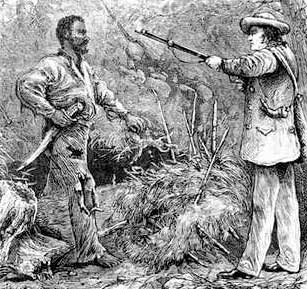
Drawing from the time
In June of 1822, nearly 135 African Americans were arrested and tried in secret. The group was accused of plotting a slave rebellion. The alleged leader of the rebellions was Denmark Vessey, a free Black Man, living in Charleston. As a result of the trial, 35 slaves were executed and another 43 transported and sold in distant locations. There remains a controversy among historians as to whether Vesey was indeed planning a rebellion or not. The opposing opinion suggest Vessey and his fellow "conspirators" may have been victims of either white hysteria or a political manipulations. Regardless of the initial intent, Vessey's Rebellion, had a long term impact. The event solidified southern opposition to all abolitionist activity. Southern opposition became more militant, as many southerners believed it was abolitionist propaganda that incited the slaves to revolt.
Denmark Vessey grew up in St. Thomas, which was then part of the Danish West Indies. He was sent to work on the sugar plantations of Haiti but was returned by his owner - deemed unsuitable. Vesey was sold to a Charleston man, and as was the custom of the time, Vessey was able to hire himself out on his own time, as long as he turned over most of his earnings to his master. In 1799, Vessey won a $1500 in a lottery. He was able to buy his freedom and set himself up as a carpenter. He was successful in his trade, but resented what the white men had done to him. According to the traditional history of events, Vessey organized a large number of slaves who were to mount a surprise revolt, seize the arms in the household and kill their masters. On May 25th, a slave informed his master on the attempt to recruit him to revolt. The authorities had a hard time investigating the conspiracy; none of the other slaves would talk. Finally, when the authorities heard the rebellion was imminent, the authorities arrested all potential conspirators. They created a special tribunal in which a few slaves testified against Vesey and the key conspirators. Vesey himself and the key conspirators remained silent with the words "Die silent, as you see me do". 35 of the conspirators were executed, 43 sold and transported out of the area. The rest were either acquitted or never charged. In the aftermath of the trials Southerners would be forever fearful of another revolt.
A new revisionist history of the event claims the revolt never was going to take place. According to this theory, the plot was an attempt by the politically ambitious mayor, who used the plot to discredit the governor and advance his own career. Furthermore, the theory suggests those who testified against Vesey were given a stark choice: testify falsely and live or keep silent and be executed.
 >
>